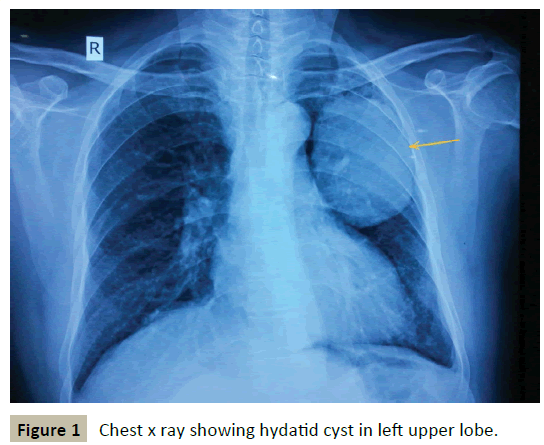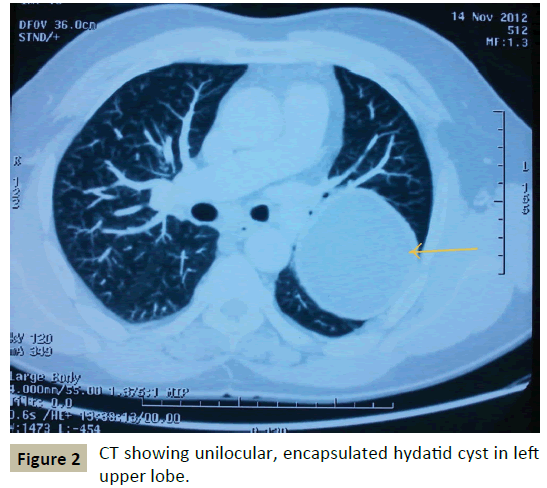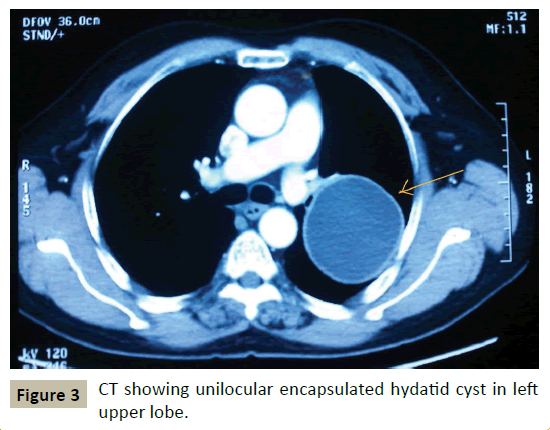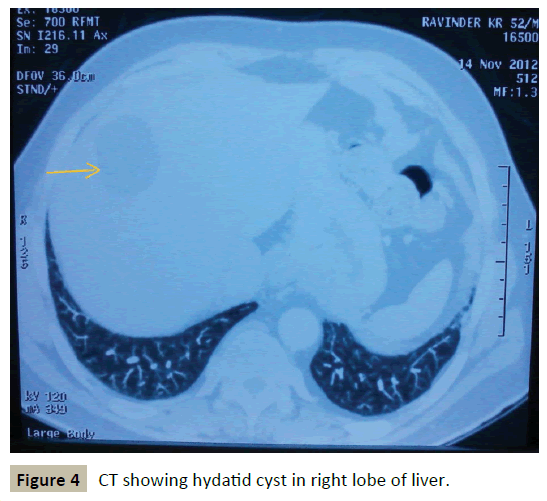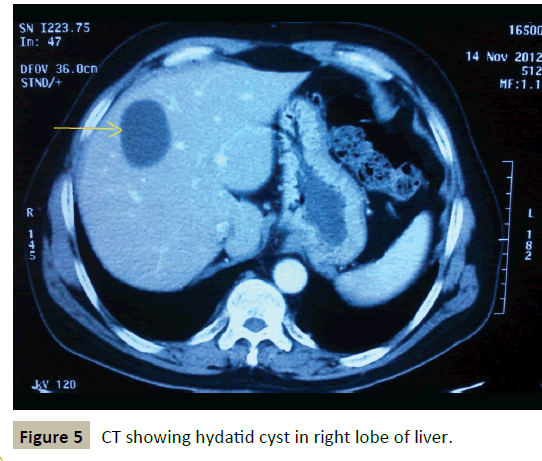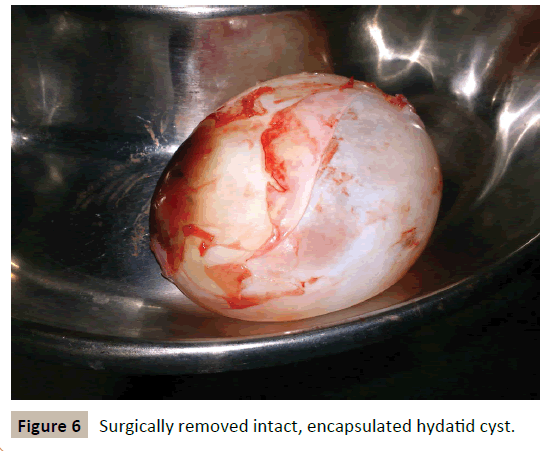Monish S Raut* and Arun Maheshwari
Department of Cardiac Anesthesia, Dharam Vira Heart Center, Sir Ganga Ram Hospital, Old Rajinder Nagar, New Delhi, India
- *Corresponding Author:
- Monish S Raut
Department of Cardiac Anesthesia, Dharam Vira Heart Center
Sir Ganga Ram Hospital, Old Rajinder Nagar, New Delhi, India
Tel: 919582731093
E-mail: drmonishraut@gmail.com
Received date: July 26, 2016; Accepted date: July 28, 2016; Published date: August 04, 2016
Citation: Raut MS, Maheshwari A. Uncommon Hydatid Cyst in Lung. J Intensive & Crit Care 2016, 2:3.
Introduction
Echinococcosis also called as hydatidosis is the important zoonotic diseases caused by Echinococcus granulosus. The parasite resides in the intestines of dogs, cats as well as in sheep. Eggs are eliminated with feces and they contaminate fields, irrigated land and wells. Primary host animals ingest the eggs, which develop into larvae, or hydatids in the intestine of these animals. Man acquires the disease through water or food or by direct contact with dogs. The embryos are released once the eggs reach stomach. Through the intestinal wall, they reach the veins of the liver, forms vesicles and develop into hydatids. They can reach lung once they cross liver. Various path to reach lungs are lymphatic vessels, bypassing the liver, and through the bronchi [1]. Hydatid disease involves the liver commonly in approximately 75% of cases, with uncommon presentation in lung [2-4].
Case Report
54 years male patient presented with cough and shortness of breath. On auscultation, bronchial breathing sound was heard over left apical lung field. Chest x-ray revealed circular lesion in left upper lobe (Figure 1). Computed tomography (CT) showed unilocular cystic mass measuring 4.5 cm × 7.8 cm × 5.6 cm in dimensions, in left upper lobe with subsegmental atelectasis of adjacent parenchyma (Figures 2 and 3). Similar cystic mass was also seen in right lobe of liver (Figures 4 and 5). CT features suggested hydatid cyst, the diagnosis was confirmed by ELISA for echinococcus. Subsequently, oral albendazole therapy was started. After smooth anesthesia induction, left side double lumen tracheal tube was inserted to isolate lung ventilation. Left lateral thoracotomy was performed for enucleation of intact cyst (Figure 6). Patient was stable and postoperative course was smooth.
Figure 1: Chest x ray showing hydatid cyst in left upper lobe.
Figure 2: CT showing unilocular, encapsulated hydatid cyst in left upper lobe.
Figure 3: CT showing unilocular encapsulated hydatid cyst in left upper lobe.
Figure 4: CT showing hydatid cyst in right lobe of liver.
Figure 5: CT showing hydatid cyst in right lobe of liver.
Figure 6: Surgically removed intact, encapsulated hydatid cyst.
Discussion
X rays give the clue to the diagnosis of an intact echinococcal cyst. The cyst is seen as homogeneous spherical opacity with definite edges radiographically. Computed tomography and magnetic resonance imaging gives the clear picture of hydatid disease of the lung. Serological tests have limited diagnostic use. It is diagnosed by viewing the cystic membrane. Pulmonary hydatid cysts mostly involve one lobe in 72% of cases, usually at the lung base [5-7]. Circular or oval image with well-defined limits generally indicate hydatid cyst not connected to pleura. The pneumopericyst appearance indicates cyst rupture. If the content communicates with the bronchial tree, a cavity appearance like in tuberculosis or pulmonary abscesses is seen. Camelot sign or waterline image appears when the content is only partially evacuated [8]. Anaphylactic reactions can be seen after the rupture of cysts. Medical management with albendazole and/or Praziquantel is effective in selected patients. Albendazole was given 10 mg/kg/ day for 21 days postoperatively and the treatment was repeated twice with an interval of one week in high-risk groups. The results of medical treatment for hydatid disease of the lung are controversial. Failure rate of medical therapy and the recurrence rate after the treatment are high [9].
Percutaneous drainage and treatment with a cystocidal agent is generally not preferred due to risk of anaphylaxis from the released cystic fluid [10]. Surgery is the conventional treatment of hydatid cysts in all organs. The complete excision of the cyst through thoracotomy, including the germinative membrane, with the maximum preservation of lung tissue is the preferred treatment [11]. Video-assisted thoracic surgery (VATS) can also be tried for selected patients [12]. Though the benefits of one lung versus two lung ventilation are controversial, anaesthetic implication of double lumen tube is that healthy lung must be isolated in order to protect it against inadvertent rupture of the cyst occurs during its dissection and exposure. Intraoperative cyst rupture can produce serious anaphylactic reactions and prophylaxis against anaphylaxis is recommended [13].
References
- Burgos R, Varela A, Castedo E, Roda J, Montero CG, et al. (1999) Pulmonary hydatidosis: surgical treatment and follow-up of 240 cases. Eur J Cardiothorac Surg 16: 628-635.
- Pumarola A, Rodriguez-Torres A, García-Rodriguez JA, Piédrola-Angulo G (1990) Microbiología y parasitologíamédica 2nd ed. Salvat, Barcelona, Spain.
- King CH (1995) Cestodes (tapeworms) In: Mandell GL, Bennett JE, Dolin R (edr.) Principles and practice of infectious diseases. Churchill Livingstone, New York.
- Beggs I (1985) The radiology of hydatid disease. AJR Am J Roentgenol 145: 639-648.
- Mahmoud AAF (1988) Helminthic disease of the lungs. In Pulmonary Disease and Disorders. 2nd edition. McGraw-Hill, New York.
- Arora VK, Varma R (1991) Right-sided chest pain with progressive dyspnea. Chest 100: 811-812.
- Harlaftis NN, Aletras HA, Symbas PN (2005) Hydatid disease of the lung. In: Shields TW (edr.) General Thoracic Surgery. Lippincott Williams and Wilkins, Philadelphia.
- Pasto M, Curull V, Minguella J, Jimenez MA, Sanjuas C, et al. (1995) Haemoptysis and a cavity in a young man. EurRespir J 8: 481-482.
- Shields TW (1994) General thoracic surgery. Willams & Wilkins Fourth Edition II: 1021-1027.
- Mawhorter S, Temeck B, Chang R, Pass H, Nash T (1997) Non-surgical therapy for pulmonary hydatid cyst disease. Chest 112: 1432-1436.
- Erdogan A, Ayten A, Demircan A (2005) Methods of surgical therapy in pulmonary hydatid disease: Is capitonnage advantageous? ANZ J Surg 75: 92-96.
- Shabb BR, Agabeyad F (2000) Hydatid cysts of the lung. In: Yim APC, Hazelrigg SR, Izzat MB, Landreneau RJ, Mack MJ, et al. (edr.) Minial Access Cardiothoracic Surgery. WB Saunders, Philadelphia.
- Sola JL, Vaquerizo MJ (1995) Intraoperative anaphylaxis caused by a hydatid cyst. Acta Anesthesiol Scand 39: 273-274.

